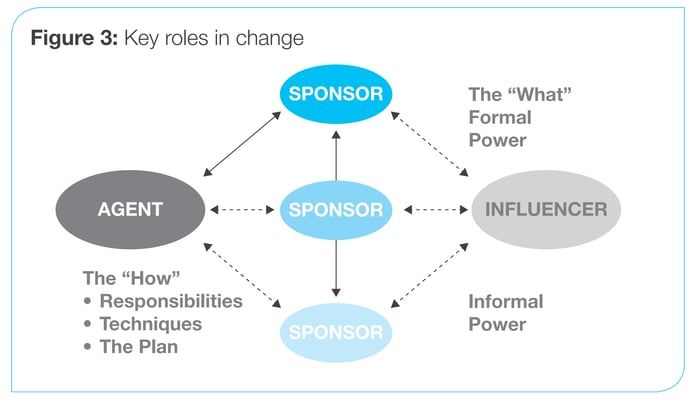
Creating a strong sponsor network can be a bit daunting when also faced with establishing and driving a strategic change initiative. Especially for those new to a change leadership role, or those new to an organization. We wanted to share with you some tips on how to create a strong sponsorship network to give your strategic change the foundation for success.
The sponsor role is not aligned to one single person
The sponsor is a critical role in any change. Last week, we talked about the sponsor role and that it is not necessarily one person. We use this term to mean all the people who have the accountability to make change happen. In successful change implementations, sponsors work together in a network to spearhead, and cascade, change down through the organization.
The question for the change agent is how to create a strong sponsor network in their organization. We have found that there are clear actions organizations undertake to develop a strong sponsor network.
- Map out a change network
Mapping out the change network is more than just identifying the executive sponsor and the senior leaders. Change sponsorship needs to happen at every level; during the middle of a change lifecycle it is often the middle and front line managers who have the ability and local power to drive through changes.
Using an organizational chart is a good start, but is not the end solution. Understand how accountability to deliver the change will be cascaded down from the top. Map out the influencer roles as well to ensure that all 3 roles of change leadership cover the organization.

It is a good idea to map out the future change state against your change network to identify the impact of the change to your change leaders. Changing the functional leadership structure, for example, may change the sponsorship accountabilities during the change, or create a hole in the communication network.
- Engage sponsors at every level
Now that you have your sponsors identified across the organization they need to be engaged. Creating a powerful engagement process, not only for the people in the organization but also for the sponsors across your organization, is important. In fact, this is a primary concern as your sponsors will be role modeling the actions and behavior of the new change state.
Ensure your sponsors understand what is required of them, the responsibilities of their role and the commitment needed from each and everyone one of them.
During change, it is just as important for the local sponsor to be visibly supporting the change, and accessible for dialogue with their team, as it is for the executive sponsor and senior leaders.
Engaging sponsors means ensuring the right people are on board with the correct seniority. That they are willing and able to fulfill the function of a sponsor, and that they are fully prepared and aligned with the change initiative.
- Facilitate networked connections
Do not assume that your sponsors will automatically reach out and connect with each other. This is even more true where the network crosses functional or organizational boundaries.
Bring sponsors together for cross organizational meetings and discussion sessions when you are undertaking sponsor engagement activities, discussing the role and responsibilities of the sponsor role, and throughout the change lifecycle.
Encourage discussion, sharing of stories and lessons learnt. While the sponsors’ accountability may be in very different functional areas, they will find that they are facing similar reactions and obstacles as each other, and can learn from one another.
While it may not be feasible to get your sponsors together face-face, technology based tools mean that sharing and collaborating in a virtual environment is feasible, and effective.
- Provide space for sponsors to embrace the change
You may face resistance in your sponsorship network. This is completely normal. Your change sponsors are people too, and they need to go through the same change cycle as their own teams will.
Do not confuse the signs of resistance as political in nature. More often than not, what is interpreted as political resistance is actually natural resistance to change. Each of your sponsors will go through their own personal change cycles at their own rate.
Ensure you have the right engagement processes in place so that your sponsors have the information they need, and the ability to have a two way discussion to work through their concerns.
Give the space, the time, for your sponsors to embrace and commit to the change before asking them to dive into their sponsorship responsibilities. A change sponsor who is resisting, or even just accepting, the change is an ineffective sponsor and can actually do harm to your strategic change.
- Provide ongoing feedback
Provide honest feedback on the effectiveness of the sponsors, their actions and their behaviors throughout the strategic change. Some of the discussions may be hard to have, but the end result will be a higher rate of success for your organizational change.
Are you interested to learn more about creating effective change leadership in your organization? Download and read our white paper Leaders of the Revolution for insights and tips on creating strong change leaders for your strategic change.


Leave a comment